Cow farming can be a lucrative business if you have enough space and are aware of what’s happening in the cattle market. Cows can be used for either milk or beef production. In addition to choosing the right breed and prioritizing the health of your cows, it’s important to consider the cost of a cow, maintenance expenses, profitable breeds, and the prices at which you can sell your cows.
The cost of a cow is between $2,000 and $5,000, while yearlings cost around $800 to $1,500. The actual cost depends on the breed, age, gender, and purpose.
Cows can be sold either as live animals or as beef meat. The price of beef cows is typically calculated per hundredweight (CWT), which is a unit of measurement equal to 100 pounds.
Raising cattle for profit can be challenging due to the fluctuating costs of feed and cow prices. However, this guide estimates prices for beef cows, dairy cows, feed costs, butchering costs, and other expenses to give you an idea of the costs involved. It also provides information on common breeds of beef and dairy cows and their characteristics.
Live Weight vs. Hanging Weight vs. Finished Weight: What’s the Difference?
Whether you are hiring a cow butcher, buying beef, or selling beef, it is important to be familiar with the terms “live weight,” “hanging weight,” and “finished weight” (also known as “package weight”).
These terms refer to the weight of a cow, but they are different from each other. Here are their definitions and how they relate to each other:
- Live weight – The weight (in pounds) of the cow while it is still alive, right before it is slaughtered.
- Hanging weight – The weight (in pounds) of the cow after it has been killed. The blood has been drained, and the head, hide, and all internal organs have been removed. This hanging weight is approximately 60% of the live weight.
- Final weight – The weight (in pounds) of the cow after all processes have been completed and the beef is ready for taking home. The finished weight is about 60% of the hanging weight, due to water loss and bone loss.
For example, the hanging weight of a 1,200-lb live cow is 1,200 x 0.6 = 720 lbs. Then, the final weight will be 720 lbs x 0.6 = 432 lbs.
How Much Does a Whole Cow Cost?
Buying and selling beef can be in bulk, half, or quarter size. The price for freezer beef is based on the hanging weight of the cow, and the actual amount of beef that buyers take home is around 30% less than the hanging weight.
The cost also depends on where it is sold. As of December 2022, a whole beef in Michigan costs about $4.55 per pound.
How Much Does Half a Cow Cost?
A half cow is one-half of a whole cow and is around 200-400 pounds of meat. The cost of a half cow in Michigan is $4.65 per pound and is based on the hanging weight of half beef.
If a half cow weighs 400 pounds, its price is $4.65 x 400 = $1,860. But since the actual weight is only 280 pounds (400 x 0.70), the actual price is $6.64 per pound.
How Much Does a Quarter Cow Cost?
A quarter cow is one-fourth of a whole cow and weighs 100-200 pounds. The cost for a quarter of beef is $4.75 and is based on the hanging weight of a quarter of beef.
The computation for the actual take-home weight of a quarter beef is the same as that of the half cow. Therefore, the actual price of a 200-pound quarter cow is $6.78 per pound.
How Much Does a Beef Cow Cost?
The cost of beef cows depends on the breed, age, and gender. Young female cows that have not yet given birth are called heifers, and a heifer that is currently pregnant with her first calf is called a bred heifer.
As of January 2023, a beef heifer costs between $2,500 and $3,000 with an average cost of $2,800, while a bred heifer costs around $1,300.
A beef yearling can cost $650 to $750 each, while a mature beef cow costs between $4,000 and $5,000 each, or about $1.85 per 100 pounds. A yearling is a young cow that is about 1-2 years old.
Meanwhile, a beef cow can cost about $140 per 100 pounds, and the price range is from $135 to $165 per 100 pounds. A 500-pound calf may cost $700.
How Much Does a Dairy Cow Cost?
As of January 2023, a dairy cow costs between $900 and $3,000, while the cost of a lactating dairy cow is between $1,500 and $2,100.
The wide price range is due to several factors, which include the age and breed of the cow, and how it was raised. Dairy cows that are bottle-fed, tamed, and hand-raised are usually more expensive.
How Much Does a Highland Cow Cost?
Highland cows are among the most popular beef cattle in the US and have very tender meat. The cost of Highland cows can be between $5,000 and $12,000, depending on age, weight, and gender.
In November 2022, a 14-month-old Highland heifer was sold in an online auction in Victoria, Australia for a whopping AUD 67,500 (approx. US$45,000)!
How Much Does a Mini Cow Cost?
As the name implies, miniature cows are cows that are smaller than usual. These mini cows are about one-third to half the size of regular cows but can be as productive as any other cow breed.
They are classified into three groups – midsize, standard, and micro-miniature. Depending on the size, a mini cow costs between $1,000 and $7,000.
What Are the Best Beef Cows to Buy?
If you are a cow farmer in the US, there are many beef cattle breeds that you can choose from. But if you are a beginner, it would be better if you choose commercial cattle.
Commercial cows are usually unregistered, may be crossbred, and are easier to manage than purebred. To help you out, here are some of the best beef cows to buy:
1. Black Angus

Black Angus is the most famous cow breed in the US. Also called Aberdeen Angus, the Black Angus cattle breed first arrived in the US from Scotland in 1873.
This medium-to-large cow breed is known for being fast growers and dedicated mothers and requires only little maintenance for calves. Bulls weigh about 1,870 lbs, while cows weigh about 1,200 lbs.
2. Charolais

Charolais cows originated in France and were introduced in the US sometime in 1936. This medium-to-large cattle breed has a very deep, broad body and heavily muscled haunches and loins.
They are also ideal in all-purpose cross-breeding. Bulls usually weigh between 2,000 and 2,500 lbs, while cows weigh between 1,250 and 1,600 lbs.
3. Hereford

Hereford cattle originated in Herefordshire County, England in the 1700s and came to the US in 1817. This white-faced beef cattle breed is very famous for being docile, early maturing, good milkers, great mothers, and easy calvers.
Hereford beef has good quality and contains plenty of marbled fat and flavored meat with a fantastic taste.
4. Simmental
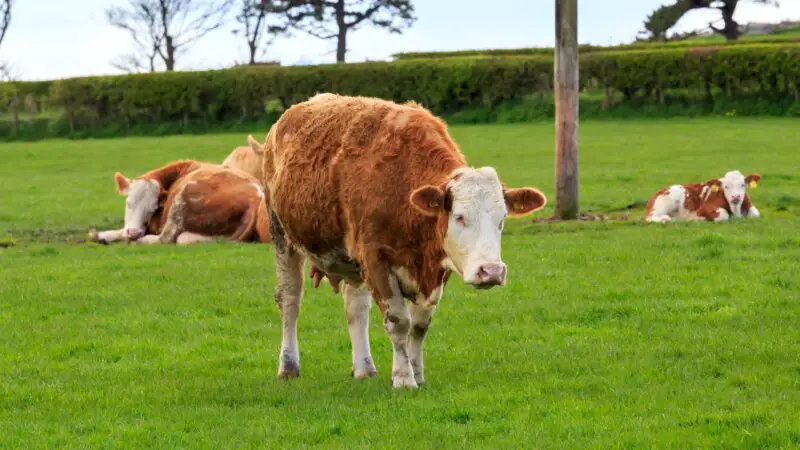
Simmental cows originated in Switzerland and were exported to Italy in the 1400s. This red and white, huge mammal was introduced in the US in 1967 and is one of the oldest and most widely distributed cattle breeds in the world.
This multi-purpose cattle breed is known for having a large body frame and rapid growth development.
5. Texas Longhorn
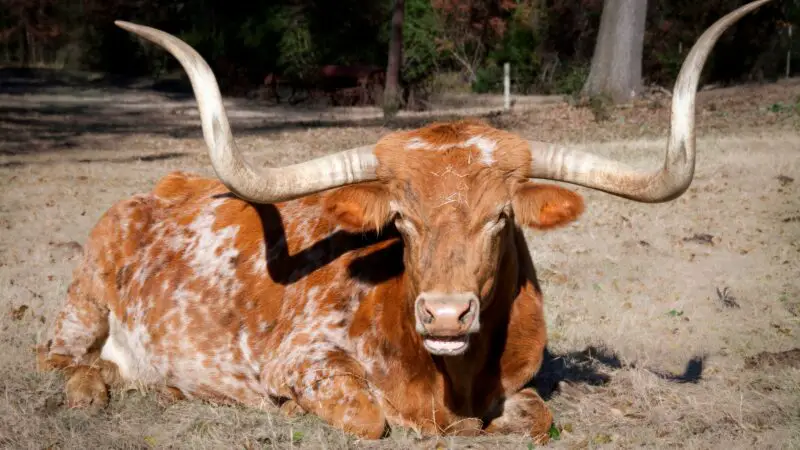
The Texas Longhorn hybrid cow breed was first brought to America during the Second Voyage of Christopher Columbus in the late 1400s.
Rescued from extinction in 1927, this beef cattle breed has long horns with a span of more than 8 ft (2.4 m) from tip to tip. Longhorns are known for their high reproductive rate and very lean meat.
6. Highland

Highland cows originated in the Scottish Highlands, hence the name, and were first imported to the US in the late 1890s.
Dubbed the oldest registered breed of cattle in the world, Highlands are famous for having dramatic shaggy coats and long horns. They don’t require too much shelter and feed supplements, and their meat is very low in fat.
What Are the Best Dairy Cows to Buy?
1. Holstein
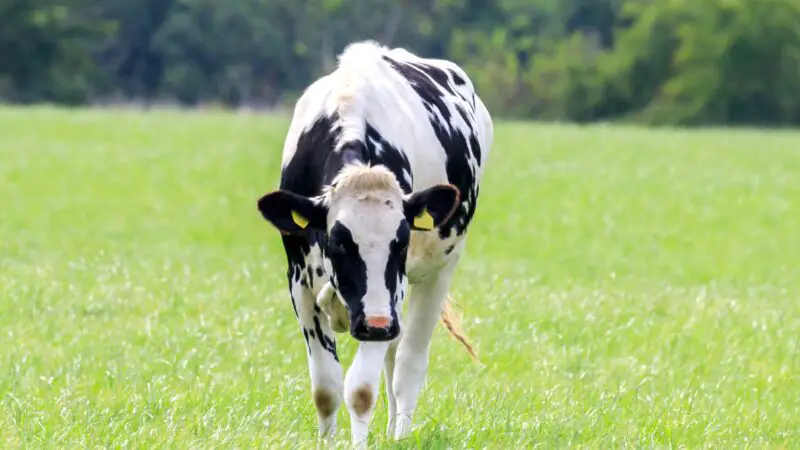
Also called Holstein-Friesian, Holstein is the highest-producing dairy cattle breed in the world. This Dutch cow breed was first brought to the US in 1852. Holstein cows cover about 90% of all dairy cows in the country.
A mature Holstein cow weighs about 1,500 lbs and can produce around 2,900 gallons of milk for every annual milking cycle.
2. Jersey
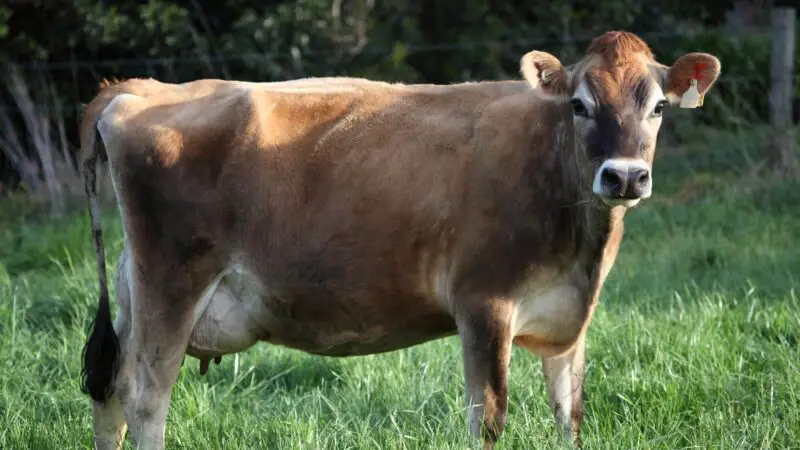
Jersey cows originated in Jersey, an island in the English Channel, and first arrived in the US in the 1850s. This dairy cow breed has a small body and a mature cow weighs only about 1,000 lbs.
Nevertheless, its milk is very rich in protein and butterfat. Based on a study, Jersey cattle are less profitable than Holstein cows but are slightly more feed efficient.
3. Brown Swiss

As the name implies, Brown Swiss cattle originate from the Swiss Alps, in Switzerland. Known as the oldest dairy cattle breed, Brown Swiss cows are docile and calm.
Their milk has a high protein-to-fat ratio, which makes it ideal for making cheese. A mature Brown Swiss cow can produce around 2,900 gallons of milk for every annual milking cycle.
4. Ayrshire
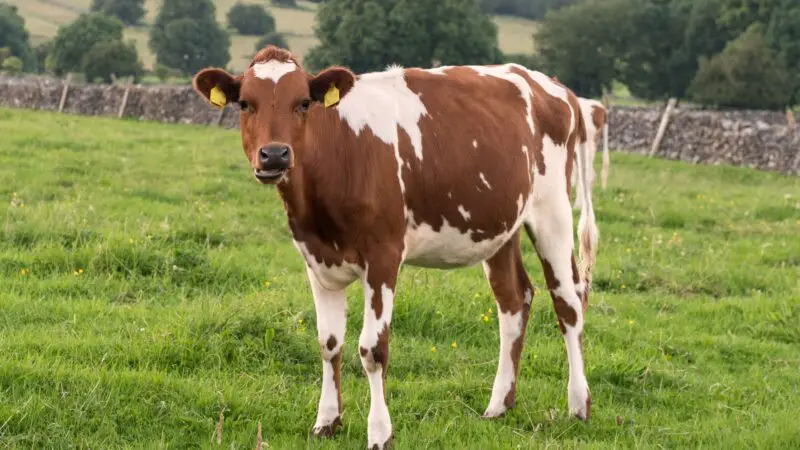
Originally known as Cunninghams, Ayrshire cows originated in Ayrshire, Scotland, hence the name. They have medium-sized bodies with horns that are over a foot long.
A mature Ayrshire cow can weigh up to 1,200 lbs. Amazingly, an Ayrshire cow named Ida from Lette Farms Betty was able to produce 37,170 pounds of milk in just 305 days!
5. Guernsey
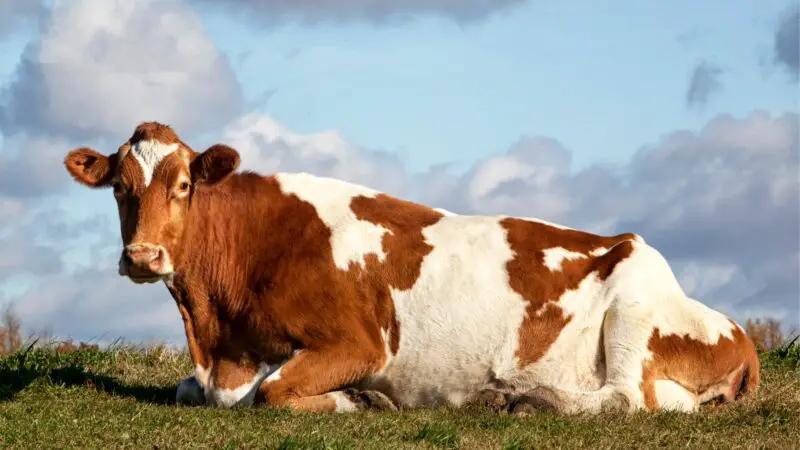
Guernsey cattle are neighbors of Jersey cows since they also originated in the English Channel on an island called Guernsey. This cow breed has a medium-sized body and requires less feed.
Mature Guernsey cows weigh between 1,200-1,300 lbs. Their milk has a “golden” color due to its high concentration of solids and is great for making cheese.
6. Milking Shorthorn
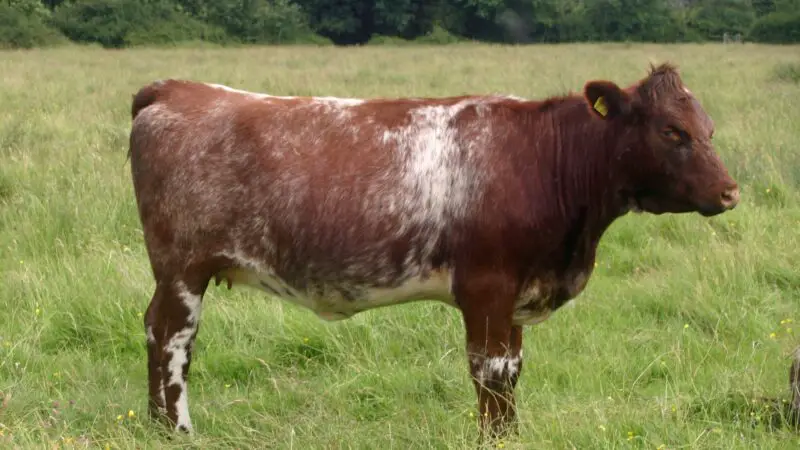
Milking Shorthorn cattle originated in the Valley of the River Tees in the Northeastern part of England. Also called Dairy Shorthorns in the UK, Milking Shorthorns were introduced in the US in 1783.
But unlike the other cows in this list, this cattle breed was originally bred for milk and beef production. The average annual milk production is about 15,000 lbs.
Where to Buy a Cow?
If you want to buy a cow, there are several places to choose from. Some options are:
- Local farms
- Cattle auctions
- Online marketplaces (such as Ranch World Ads, Cattle Exchange, and Cattle USA)
- Livestock brokers
How Much Does a Bull Cost?
Bulls play an important role in producing live calves. No wonder they are about 250% more expensive than steers (castrated bulls).
As of December 2022, steers cost about $2,000, and bulls are around $5,000 each. Although price matters when buying a bull, you should also make sure it has the genetic potential that your cow herd needs.
How Much Does It Cost to Butcher a Cow?
If you will not slaughter your cows yourself, you can hire a cow butcher to do the job. The cost of butchering a cow depends on several factors.
To start with, the butchering fee is more expensive if you hire a professional butcher instead of those with less experience. The cost also depends on the size of the cow and the services to be done.
As expected, bigger cows have more work to be done, which results in a higher cost. Aside from the butchering fee, there are also fees for cutting the meat, skinning, and gutting, as well as keeping the hide and other inedible parts.
In some cases, there will also be a storage fee. Transportation or delivery fee depends on the location of the butcher.
But to give you an idea, the average cost for butchering a whole cow is $190, and $95 for a half cow. The kill fee alone is $40-$80 per cow. The cost per pound hanging weight is around $1.25. The process includes cutting, processing, and packing the meat. If you want the meat in a shrink wrap, the cost is $0.50-$0.75 per pound of the final weight.
How Much Does It Cost to Raise a Cow?
As of January 2023, the cost of raising a cow can be between $500 and $1000, which depends on several factors. The main contributor is the feed cost, which covers about 60%-70% of the annual cost.
Hence, you can save some money if you have a few extra acres of land for cattle grazing. One cow is estimated to need at least 1.5 acres of land.
The second largest expense in raising cows is depreciation, which is not equivalent to cash. Cow depreciation is the loss once you sold old cows and replaced them with bred heifers. This can be computed by subtracting the Salvage Value from the Purchase Price or Replacement Cost, divided by the Productive Years in the Herd.
The Purchase Price is the price of a replacement heifer and includes all the expenses to produce the weaned heifer calf until it enters the herd as a bred female. The Salvage Value is the price of the cow once you place it on sale. The Productive Years in the Herd are the number of years that the cow is considered an asset or serviceable.
Another loss in cow-calf operations is the fence/facilities and equipment depreciation. Meanwhile, the cost of labor and equipment is 15-30%. The cost for breeding is $40 per cow, veterinary and medicine cost is around $25 per cow, and marketing cost is around $25 per cow. On average, the miscellaneous cost is about 5-15% of the total cost.
How Much Does It Cost to Feed a Cow?
As mentioned above, the feeding cost is the most expensive part of raising cows and is at least 60% of the total annual cost. Therefore, if your budget for raising a cow is $1,000 annually, you are likely to spend a minimum of $600 just for the feed. The average annual feed cost is $700 per cow, and the actual cost depends on the price of the feed.
According to 2022 estimates, good hay costs around $150 per ton; fair hay costs about $125 per ton; poor hay costs about $115 per ton, and raised hay costs about $90 per ton.
Note, however, that higher quality hay has less feed waste than those with poorer quality. Also, the amount of feed required mainly depends on the type of cows you are raising.
For instance, dry spring-calving cows may consume 2 lbs of good hay per head per day, 3.2 lbs of fair hay, and 5.2 lbs of poor hay. Therefore, the average cost per head per day is $2.68 for good hay, $2.38 for fair hay, and $2.48 for poor hay. For raised hay, the average daily feed cost is $1.75 for good hay, $1.86 for fair hay, and $2.15 for poor hay.
On the other hand, fall-calving cows are expected to feed more due to lactation. On average per head per day, they may consume about 2.8 lbs of good hay, 4.8 lbs of fair hay, and 6.3 lbs of poor hay.
Hence, their average daily feed cost is $2.90 for good hay, $2.68 for fair hay, and $2.68 for poor hay. The average cost of raised hay is a bit lower.
List of Sources
Are Holstein or Jersey Cows More Profitable?
Calculating Winter Feed Costs for Beef Cows
